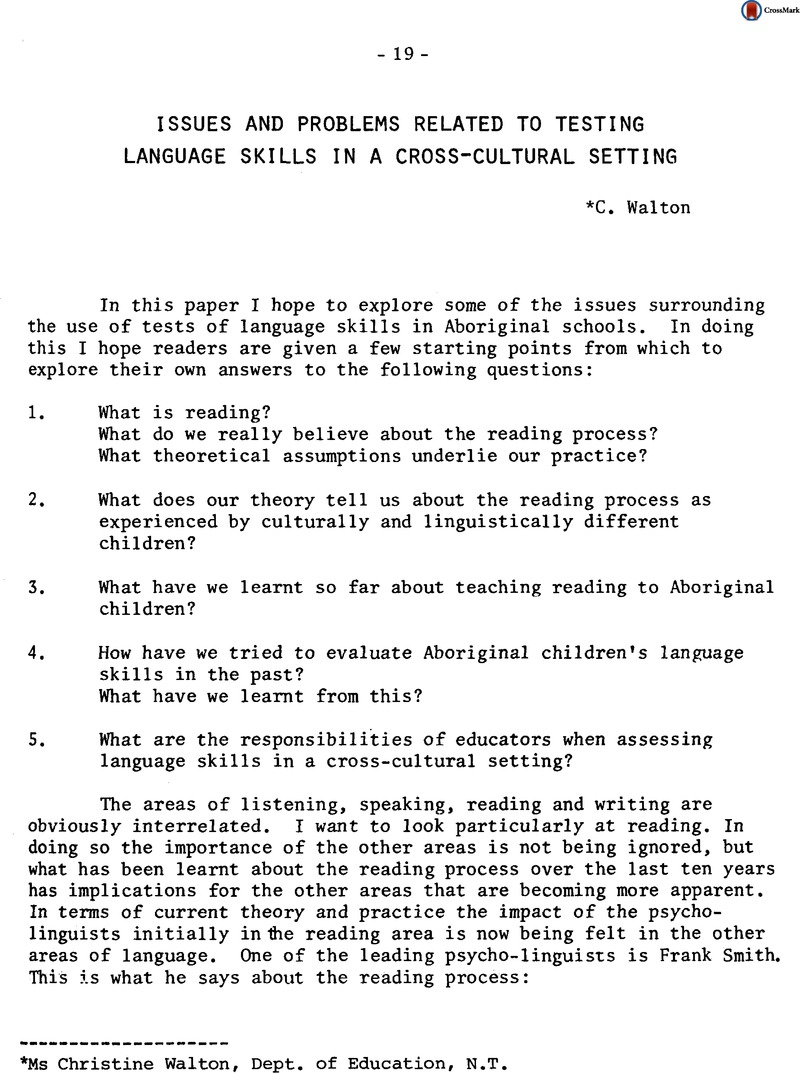No CrossRef data available.
Article contents
Issues and Problems Related to Testing Language Skills in a Cross-Cultural Setting
Published online by Cambridge University Press: 22 July 2015
Abstract
An abstract is not available for this content so a preview has been provided. As you have access to this content, a full PDF is available via the ‘Save PDF’ action button.

- Type
- Editorial
- Information
- Copyright
- Copyright © Cambridge University Press 1983
References
References
Dunn, L.M., 1965: Peabody Picture Vocabulary Test, Manual. A.G.S. Inc., Minnesota, U.S.A.Google Scholar
Dwyer, L.J.: A language program for Aboriginal children. The Exceptional Child, 23, 1, March 1976.Google Scholar
Goodman, K.S., (n.d.): Testing in reading: a general critique. In Rudell, R.R., (Ed.):Accountability and Reading Instruction Critical Issues. National Council of Teachers of Education, Urbana, Illinois, pp. 21–33.Google Scholar
Keogh, B.K., 1974: Psychological evaluation of exceptional children: old hangups and new directions. In Jones, R.L. and MacMillan, D.L. (Eds): Special Education in Transition. Allyua and Bacon Inc., Boston, U.S.A. pp. 131–6.Google Scholar
Labov, W., 1973: The logic of non-standard English. In Keddie, N. (Ed.): Tinker, Tailor...The Myth of Cultural Deprivation. Penguin Education, G.B.Google Scholar
Lopez, M., 1978: Bilingual education and the Latino student. In Valverdo, L.A. (Ed.), Bilingual Education for Latinos. Assoc. for Supervision and Curriculum Development, Washington D.C.Google Scholar
Middleton, M.R. and Francis, S.H., 1976: Yuendumu and Its Children: Life and Health on an Aboriginal Settlement. Australian Government Publishing Service, Canberra.Google Scholar
Nurcombe, B., 1976: Children of the Dispossessed. A consideration of the Nature of Intelligence, Cultural Disadvantage, Educational Programs for Culturally Different People, and the Development and Expression of Competencies. A Culture Learning Institute Monograph, East-West Center, The University Press of Hawaii.CrossRefGoogle Scholar
Severson, R.A. and Gest, K.D., 1970: Towards standardised assessment of the language of disadvantaged children. In Williams, F. (Ed.): Language and Poverty: Perspectives on a Theme. Markham Pub. Co., Chicago.Google Scholar
Smith, F., 1975: Comprehension and Learning. A Conceptual Framework for Teachers. Holt, Rinehart and Winston, U.S.A.Google Scholar
Teasdale, G.R. and de Vries, T., 1976: The use of the Illinois Test of Psycholinguistic Abilities with Aboriginal Australian children. In Kearney, G.E. and McElwain, D.W. (Eds): Aboriginal Cognition: Retrospect and Prospect. Psychology Series No.1, Australian Institute of Aboriginal Studies, Canberra. Humanities Press Inc., New Jersey, U.S.A.Google Scholar
Recommended Further Reading
Goodman, K.S., (n.d.): Testing in reading: a general critique. In Rudell, R.R., (Ed.): Accountability and Reading Instruction Critical Issues. National Council of Teachers of Education, Urbana, Illinois.Google Scholar
Smith, F., 1973: The politics of ignorance. From The Politics of Reading: Point-Counterpoint. I.R.A. Delaware.Google Scholar
McConnochie, K., 1981: White tests, black children: Aborigines, psychologists and education. In Menary, Bill (Ed.): Aborigines and Schooling. Adelaide College of Arts and Education.Google Scholar




